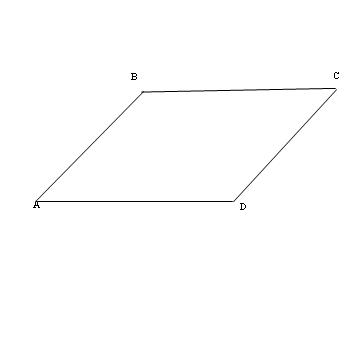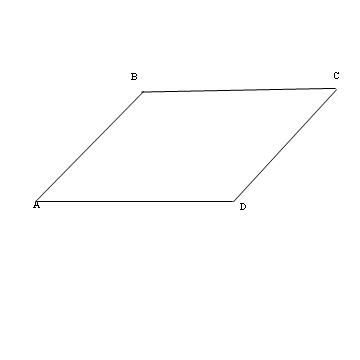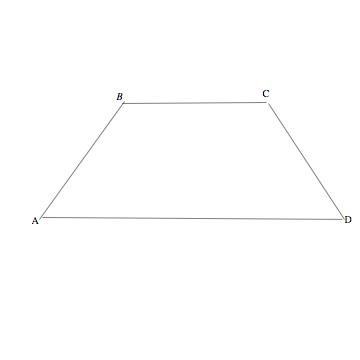Unit 6 Polygons And Properties Of Quadrilaterals Test Version B

In this second part of a two-part quiz, we’ll be continuing to test your knowledge on polygons and properties of quadrilaterals. These questions will include topics like sides of an octagon, the interior angle sum of a hexagon, and more.
- 1.
How many sides does an octagon have?
- A.
4
- B.
5
- C.
6
- D.
7
- E.
8
Correct Answer
E. 8Explanation
An octagon has 8 sides.Rate this question:
-
- 2.
What is the interior angle sum of a hexagon in degrees?
- A.
360
- B.
540
- C.
720
- D.
900
- E.
1080
Correct Answer
C. 720Explanation
The interior angle sum of a polygon can be found by using the formula (n-2) * 180, where n is the number of sides of the polygon. In the case of a hexagon, which has 6 sides, the interior angle sum would be (6-2) * 180 = 4 * 180 = 720 degrees.Rate this question:
-
- 3.
What is the measure of one exterior angle of a regular decagon?
- A.
45 degrees
- B.
36 degrees
- C.
30 degrees
- D.
20 degrees
- E.
18 degrees
Correct Answer
B. 36 degreesExplanation
The measure of one exterior angle of a regular decagon is 36 degrees. In a regular decagon, all the exterior angles are congruent, meaning they have the same measure. Since a decagon has 10 sides, the sum of all the exterior angles is 360 degrees. Therefore, each exterior angle is 360 degrees divided by 10, which equals 36 degrees.Rate this question:
-
- 4.
What is the measure of one interior angle of a regular pentagon?
- A.
150 degrees
- B.
144 degrees
- C.
108 degrees
- D.
90 degrees
- E.
60 degrees
Correct Answer
C. 108 degreesExplanation
The measure of one interior angle of a regular pentagon is 108 degrees. In a regular polygon, all interior angles are equal. To find the measure of each angle, we can use the formula (n-2) * 180 / n, where n is the number of sides of the polygon. For a pentagon, n is 5, so the formula becomes (5-2) * 180 / 5 = 3 * 180 / 5 = 540 / 5 = 108 degrees.Rate this question:
-
- 5.
Which of the following is true about a regular octagon?I. - It is concave.II. - It is equilateral.III.- It is equiangular.
- A.
I only
- B.
II only
- C.
III only
- D.
I and II only
- E.
II and III only
Correct Answer
E. II and III onlyExplanation
A regular octagon is a polygon with eight sides and eight angles. It is equilateral because all of its sides have the same length. It is also equiangular because all of its angles have the same measure. However, it is not concave because all of its interior angles are less than 180 degrees, making it a convex polygon. Therefore, the correct answer is II and III only.Rate this question:
-
- 6.
In parallelogram ABCD shown below, angle A = 50 degrees, what is the measure of angle C?
Correct Answer
50
50 degreesExplanation
The measure of angle C in parallelogram ABCD is also 50 degrees. This is because opposite angles in a parallelogram are congruent, meaning they have the same measure. Therefore, since angle A is 50 degrees, angle C must also be 50 degrees.Rate this question:
- 7.
In parallelogram ABCD, if angle A = 40 degrees, what is the measure of angle B?
Correct Answer
140
140 degreesExplanation
Since opposite angles in a parallelogram are equal, angle B must also be 40 degrees. This is because angle A and angle B are opposite angles in parallelogram ABCD.Rate this question:
- 8.
In parallelogram ABCD, if the measure of angle A = 3x + 10 degrees and the measure of angle C = 4x degrees, what is x in degrees?
Correct Answer
10
10 degreesExplanation
The angles in a parallelogram are congruent, meaning they have the same measure. Therefore, angle A and angle C must be equal. Setting the two expressions equal to each other, we can solve for x. 3x + 10 = 4x. Subtracting 3x from both sides gives 10 = x. Therefore, x is equal to 10 degrees.Rate this question:
- 9.
In parallelogram ABCD, if AB = 8x - 2 and CD = 6x + 8, what is the length of AB?
Correct Answer
38Explanation
The length of AB can be found by equating it to 8x - 2. Since no other information is given about the parallelogram, we can assume that AB is one of the sides of the parallelogram. Therefore, the length of AB is 8x - 2, which is equal to 38.Rate this question:
- 10.
In parallelogram ABCD below, AE = 8. What is the measure of CE?
Correct Answer
8Explanation
In a parallelogram, opposite sides are equal in length. Since AE = 8, CE must also be equal to 8.Rate this question:
- 11.
In parallelogram ABCD below, BE = 7, what is the length of BD?
Correct Answer
14Explanation
Since BE is equal to 7, and the opposite sides of a parallelogram are equal in length, BD must also be equal to 7. Therefore, the length of BD is 14.Rate this question:
- 12.
In rectangle ABCD shown below, AC = 10x and BD = 30.What does x equal?
Correct Answer
3Explanation
In the given rectangle ABCD, AC is equal to 10 times x and BD is equal to 30. Since AC and BD are diagonals of the rectangle, they are equal in length. Therefore, 10x = 30. Dividing both sides of the equation by 10, we get x = 3.Rate this question:
- 13.
In the rectangle shown below, find the measure of x in degrees.
Correct Answer
100
100 degrees - 14.
In the rhombus below, find x if MA = 2x + 5 and AT = 3x - 2.
Correct Answer
7Explanation
In a rhombus, opposite sides are equal. Therefore, MA = AT. Setting the given expressions equal to each other, we get 2x + 5 = 3x - 2. Solving this equation, we find x = 7.Rate this question:
- 15.
In rhombus MATH, which of the following are true?I. MT = AHII. MA = AT = TH = MHIII. MY = AY.
- A.
I only
- B.
II only
- C.
III only
- D.
I and II only
- E.
I, II and III
Correct Answer
B. II onlyExplanation
In a rhombus, opposite sides are congruent. Therefore, in rhombus MATH, we can conclude that MA = AT = TH = MH. This is the only statement that is true, so the correct answer is II only.Rate this question:
-
- 16.
In the square below, if AE = 5, what is DE?
- A.
5
- B.
10
- C.
2.5
- D.
Not enough information
Correct Answer
A. 5Explanation
Since the square has equal sides, we can conclude that DE is also equal to 5.Rate this question:
-
- 17.
In the square shown below, which of the following are true?I. Diagonals AC and BD are congruentII. Diagonals AC and BD are perpendicular.III. Angle BAD is a right angle.
- A.
I only
- B.
II only
- C.
III only
- D.
I and II only
- E.
I, II and III
Correct Answer
E. I, II and IIIExplanation
In the given square, all the statements I, II, and III are true. Statement I is true because diagonals AC and BD are congruent since they both have the same length and intersect at their midpoints. Statement II is true because diagonals AC and BD are perpendicular to each other, forming right angles. Statement III is true because angle BAD is a right angle, as all angles in a square are right angles. Therefore, the correct answer is I, II, and III.Rate this question:
-
- 18.
In Isosceles Trapezoid ABCD, AB = 8x and CD = 32. Find the value of x.
Correct Answer
4Explanation
In an isosceles trapezoid, the non-parallel sides are congruent. This means that AB = CD. Therefore, if AB = 8x and CD = 32, we can set up the equation 8x = 32 and solve for x. Dividing both sides of the equation by 8, we get x = 4.Rate this question:
- 19.
In Isosceles Trapezoid ABCD, diagonal AC = 2x + 3 and diagonal BD = 4x - 5. Find the length of AC.
Correct Answer
11 - 20.
What do an isosceles trapezoid and a rectangle have in common?I. congruent diagonalsII. diagonals bisect each otherIII. right angles
- A.
I only
- B.
II only
- C.
III only
- D.
I and II only
- E.
I, II and III
Correct Answer
A. I onlyExplanation
An isosceles trapezoid and a rectangle have congruent diagonals in common. This means that the diagonals of both shapes have the same length.Rate this question:
-
- 21.
The length of one side of a square is 10 cm. Find the length of the diagonal to the nearest tenth. Hint: you can use Pythagorean Theorem or the 45-45-90 triangle created.
- A.
14.1
- B.
17.3
- C.
7.1
- D.
5.8
- E.
10.0
Correct Answer
A. 14.1Explanation
The length of the diagonal of a square can be found using the Pythagorean Theorem. In a square, the diagonal forms a right triangle with the sides of the square. The length of one side of the square is given as 10 cm. Using the Pythagorean Theorem, we can find the length of the diagonal. The formula is d = √(a^2 + b^2), where d is the length of the diagonal, and a and b are the lengths of the sides of the square. In this case, a and b are both 10 cm. Plugging in the values, we get d = √(10^2 + 10^2) = √(200) ≈ 14.1 cm.Rate this question:
-
Quiz Review Timeline +
Our quizzes are rigorously reviewed, monitored and continuously updated by our expert board to maintain accuracy, relevance, and timeliness.
-
Current Version
-
Oct 25, 2024Quiz Edited by
ProProfs Editorial Team -
Apr 14, 2010Quiz Created by
Annacabral
















